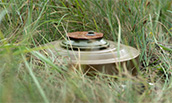Support CISR’s work empowering the professionals working in mine action: The Journal of Conventional Weapons Destruction
For 29 years, The Journal has served as the world’s leading publication that supports information exchange and disseminates research on cutting-edge technologies, operational practices, and contextual knowledge to promote excellence and integrity in the humanitarian mine action sector.
YOU CAN HELP!
CISR is seeking several sponsoring partners to continue this important work.
- Please give to CISR to support The Journal! Every dollar counts.
- Ask your organization to sponsor The Journal in exchange for acknowledgment in our publication, which reaches readers in nearly 200 countries with 200,000+ downloads over the last year.
- Continue reading The Journal on the JMU Scholarly Commons.
Your donation helps improve lives.
Your tax-deductible donation contributes directly to CISR supports programs that help survivors thrive in the aftermath of conflict. For more information contact CISR at cisr@jmu.edu.
Donations are processed securely through the JMU Foundation website.
























